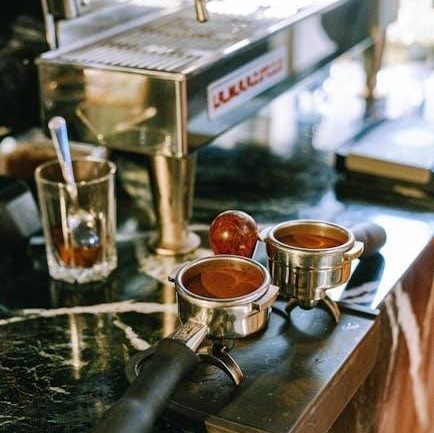Vintage manual coffee grinders are timeless tools cherished for their craftsmanship and functionality. They offer a tactile coffee-grinding experience, blending tradition with precision, appealing to coffee enthusiasts worldwide.
1.1 Definition and Overview
A vintage manual coffee grinder is a device used to grind coffee beans without electricity, relying on manual effort. These grinders typically feature a hand-crank mechanism that crushes beans into varying coarseness levels. They are cherished by coffee enthusiasts for their portability, durability, and nostalgic appeal. Unlike modern electric grinders, vintage manuals offer a hands-on, tactile experience, allowing users to control the grind size precisely. Their craftsmanship and historical charm make them both functional and collectible items in the world of coffee culture.
1.2 Historical Significance
Manual coffee grinders have roots tracing back to the early days of coffee consumption. Originating in the 17th century, they were essential tools for households and cafes, enabling fresh coffee grinding before electric alternatives existed. These grinders played a pivotal role in shaping coffee culture, offering a reliable method to prepare beans for brewing. Their design evolved over centuries, reflecting advancements in materials and mechanisms. Today, vintage manual grinders are sought-after collectibles, symbolizing a connection to coffee’s rich history and the artisanal craftsmanship of earlier eras.
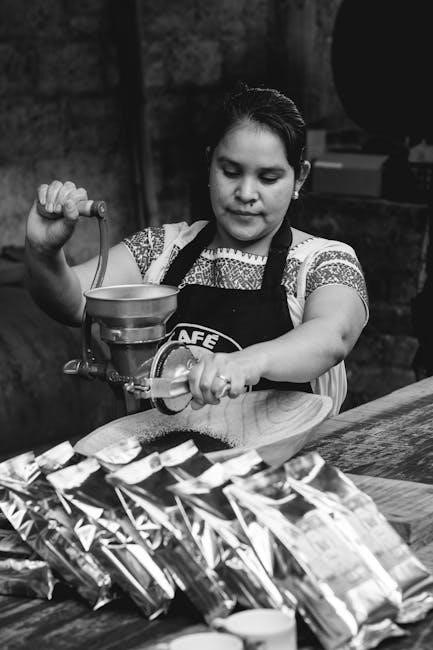
History and Evolution of Manual Coffee Grinders
Manual coffee grinders evolved from primitive mortar-and-pestle methods to refined mechanisms, with materials shifting from wood to metal. Innovations in the 19th century introduced adjustable grind settings, enhancing functionality and user control.
2.1 Early Origins of Coffee Grinding
Coffee grinding traces its roots to ancient Ethiopia, where coffee beans were crushed using mortars and pestles around the 9th century. This primitive method spread throughout the Arabian Peninsula, with early grinders resembling spice mills. By the 16th century, hand-powered grinding devices emerged in the Middle East, marking the beginning of mechanical coffee grinding. These early tools laid the foundation for the development of manual grinders, blending functionality with craftsmanship to pave the way for modern designs.
2.2 Evolution of Grinder Designs
Manual coffee grinder designs evolved significantly over centuries, reflecting advancements in technology and materials. Early grinders were simple, with hand-cranked mechanisms emerging in the 17th century. By the 19th century, industrialization introduced mass-produced, more sophisticated models with interchangeable burrs. Victorian-era grinders often featured ornate designs, blending functionality with aesthetics. The 20th century saw the rise of compact, portable grinders, catering to home use. These innovations not only improved grinding efficiency but also laid the groundwork for the diverse range of manual grinders available today, cherished for their durability and craftsmanship.
2.3 Role in Coffee Culture Development
Manual coffee grinders played a pivotal role in shaping coffee culture, serving as a bridge between tradition and modernity. They fostered a sense of community, as grinding became a shared ritual in homes and cafes. The tactile process of grinding enhanced the coffee experience, emphasizing craftsmanship and flavor. By preserving traditional methods, vintage grinders inspired a movement toward artisanal coffee, influencing today’s specialty coffee scene. They remain symbols of heritage, connecting generations to the roots of coffee preparation and the joy of a meticulously crafted cup.
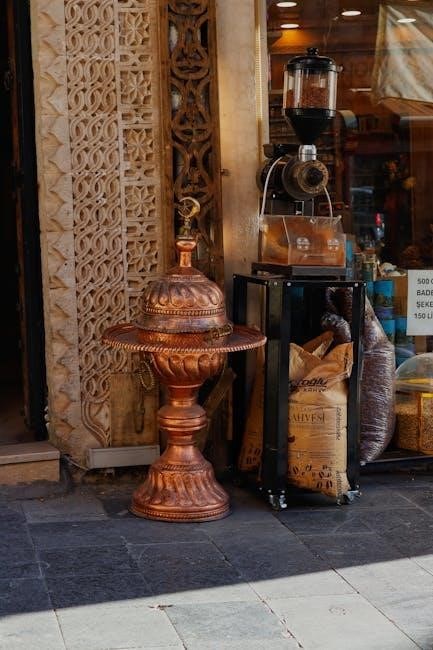
Design and Construction of Vintage Grinders
Vintage grinders were crafted with durability and style, featuring high-quality materials like wood and metal. Their intricate designs reflected attention to detail and timeless functionality.
3.1 Materials Used in Construction
Vintage manual coffee grinders were often constructed from durable, high-quality materials such as brass, copper, and cast iron, ensuring longevity and resistance to wear. Wood was frequently used for handles and exterior casings, adding a touch of warmth and craftsmanship. These materials were chosen for their strength, aesthetic appeal, and ability to withstand the rigors of daily use. The combination of metals and wood not only enhanced functionality but also contributed to the grinders’ timeless charm and collectibility. The craftsmanship in material selection reflects the era’s emphasis on quality and sustainability.

3.2 Mechanisms and Functional Parts
Vintage manual coffee grinders typically feature a handle, crank, and grinding mechanism. The handle powers the crank, which rotates the grinding burrs. These burrs, often made of steel or ceramic, crush the coffee beans. The grinder includes a hopper for beans, an adjustment mechanism for grind size, and a collection chamber for grounds. The axle and stabilizing components ensure smooth operation. The design emphasizes simplicity and durability, with materials like metal and wood ensuring reliability over time. These functional parts work harmoniously to produce consistent grinds, essential for a perfect brew.
3.3 Aesthetic Appeal and Antique Value
Vintage manual coffee grinders are cherished for their timeless design and craftsmanship. Often featuring intricate details like engravings or ornate woodwork, they embody a bygone era of artisanal quality. Their compact, ergonomic build and classic materials, such as brass or polished wood, add to their visual charm. As antiques, these grinders gain value based on rarity, condition, and historical significance. Collectors prize them for their functionality and decorative appeal, with restored pieces often commanding higher prices. Their beauty and heritage make them both functional tools and cherished display items.
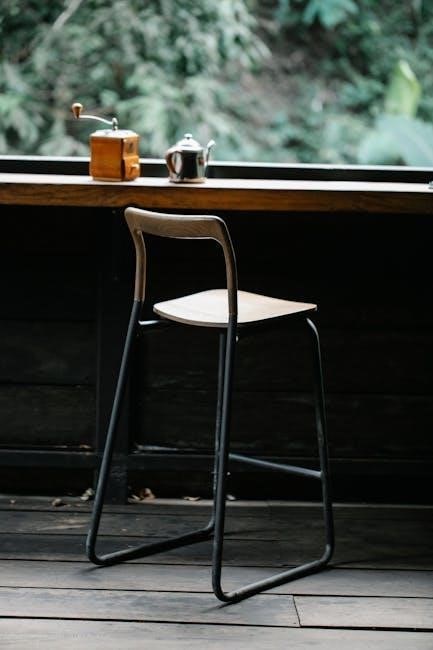
Functionality and Usage
Vintage manual coffee grinders offer precise control over grind size, ensuring optimal extraction. Their simple, durable design makes them ideal for daily use, providing a consistent result.
4.1 How Vintage Grinders Work
Vintage manual coffee grinders operate via a simple, mechanical process. Coffee beans are poured into a hopper, and a handle is turned, rotating burrs that crush the beans. The grind size is controlled by adjusting the distance between the burrs, allowing for customization. The grounds collect in a lower chamber, ready for brewing. This manual method ensures a consistent grind and minimal heat generation, preserving the coffee’s flavor and aroma. The process combines ease of use with precision, making vintage grinders a beloved tool for coffee enthusiasts.
4.2 Benefits Over Electric Grinders
Vintage manual coffee grinders offer several advantages over electric models. They produce less noise, allow precise control over grind size, and are more cost-effective. The manual process generates no heat, preserving the coffee’s natural oils and flavors. Portability is another benefit, as they don’t require electricity. Additionally, manual grinders are durable, low-maintenance, and environmentally friendly. They also provide a tactile, meditative experience, connecting users to the coffee-making process. These benefits make vintage grinders a preferred choice for coffee purists seeking quality and tradition.
4.3 Step-by-Step Grinding Process
Using a vintage manual coffee grinder involves a straightforward process. Start by preparing the grinder, ensuring it’s clean and free of residue. Add the desired amount of coffee beans to the hopper, adjusting the grind setting by turning the dial. Hold the grinder firmly and crank the handle steadily, applying consistent pressure. The beans are crushed between the burrs, with the grounds collecting in the chamber below. Continue grinding until the desired quantity is achieved, then pour the grounds into your brewing device. This method ensures a fresh, personalized grind every time.
Maintenance and Restoration Tips
Regular cleaning prevents residue buildup. Lubricate moving parts with food-safe oils. Polish metal components gently to maintain shine. Store in a dry place to preserve functionality and aesthetics.
5.1 Cleaning and Lubrication
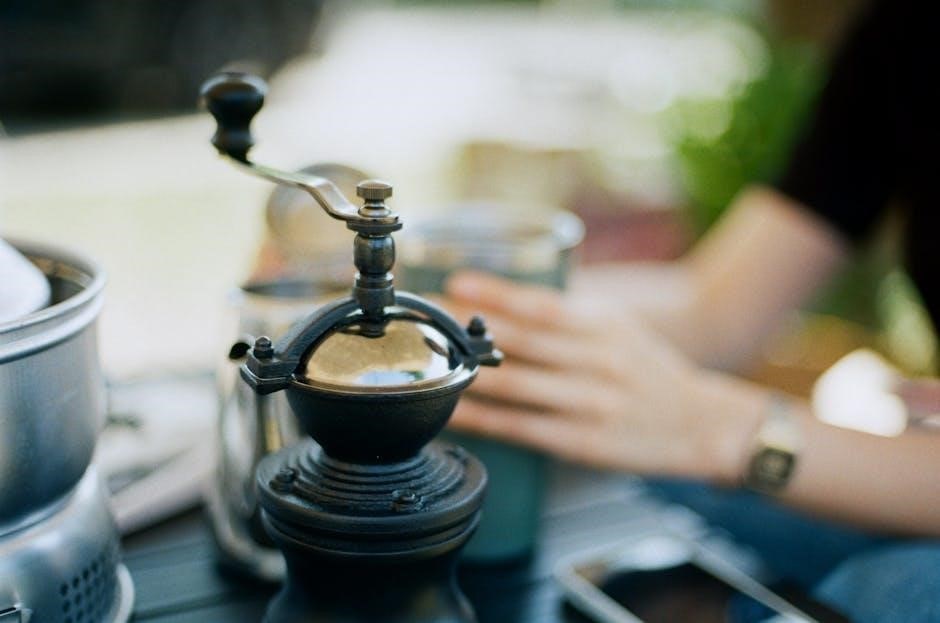
Cleaning vintage grinders involves gently brushing burrs with a soft brush and wiping exteriors with a damp cloth. Avoid harsh chemicals to preserve finishes. Lubricate moving parts with food-safe oils like mineral oil or silicone spray, applying lightly to axles and hinges. Excess oil should be wiped off to prevent residue buildup. Regular maintenance ensures smooth operation and prevents rust. Proper care extends the grinder’s lifespan and maintains its functionality for years of reliable use. Consistent upkeep also enhances its antique appeal and value over time.
5.2 Restoring Antique Grinders
Restoring vintage manual coffee grinders requires careful disassembly and inspection. Gently remove all parts, taking note of their condition and functionality. Clean each component using mild detergents and soft brushes to avoid damage. Sharpen or replace worn burrs, and address rust with gentle abrasives or rust removers. Reassemble the grinder, ensuring proper alignment and functionality. Apply food-safe lubricants to moving parts for smooth operation. Consider refinishing or repainting if desired, while preserving original finishes for authenticity. Finally, test the grinder with coffee beans to ensure optimal performance.
5.3 Tips for Longevity
To ensure your vintage manual coffee grinder lasts, clean it regularly by rinsing and drying thoroughly after use. Store it in a cool, dry place to prevent rust. Grind Coffee beans gently and avoid excessive force, which can strain mechanisms. Lubricate moving parts occasionally with food-safe oils. Avoid exposure to direct sunlight or moisture. Polish metal components periodically to maintain their finish. Use the grinder consistently to keep parts functional. For optimal longevity, handle with care and avoid over-tightening. Regular maintenance will preserve its functionality and charm for years to come.
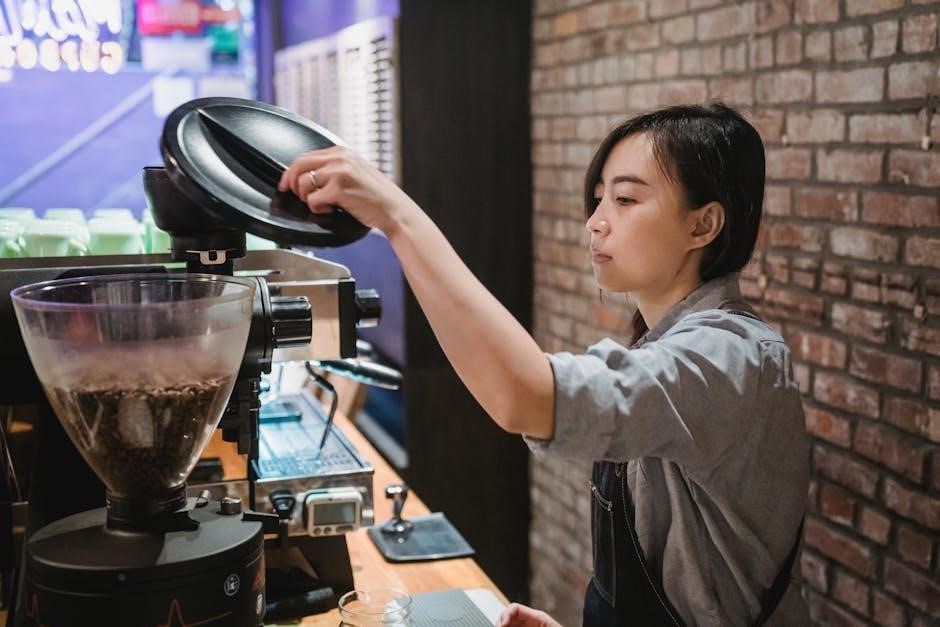
Collecting Vintage Coffee Grinders
Collecting vintage manual coffee grinders combines history, craftsmanship, and functionality. Enthusiasts seek rare models, appreciating their design, durability, and the stories they hold. A rewarding hobby for coffee lovers and antique enthusiasts alike, it connects the past with modern coffee culture, offering a unique way to preserve and celebrate heritage.
6.1 Popular Brands and Models
Popular vintage coffee grinder brands include Zassenhaus, Peugeot, and Hario, each renowned for their craftsmanship and durability. The Zassenhaus 169DG and Peugeot D75 are highly sought after for their precision engineering and timeless designs. Hario’s glass grinders, like the Mini Mill Slim, also hold a special place among collectors. These models are prized for their functionality, historical significance, and aesthetic appeal, making them valuable additions to any collection. Collectors often pursue these brands for their balance of usability and collectibility.
6.2 Where to Find Antique Grinders
Antique manual coffee grinders can be found in various places, including vintage shops, flea markets, and estate sales. Online marketplaces like eBay and Etsy often feature rare models. Specialty coffee shops and antique dealers may also carry restored grinders. Additionally, coffee collector communities and forums are excellent resources for locating unique pieces. Auction houses occasionally list high-end or rare grinders, while some enthusiasts discover them at garage sales or inherited through family. These sources offer opportunities to acquire beautifully preserved or restored vintage grinders.
6.3 Evaluating Condition and Value
Evaluating the condition and value of vintage manual coffee grinders involves assessing factors like material quality, functionality, and rarity. Grinders in excellent working condition with minimal wear command higher prices. Look for original parts, as replacements can lower value. Brands like Peugeot or Zassenhaus are highly sought after. Historical significance and collectibility also impact value. Aesthetic appeal, such as ornate designs, can boost desirability. Consulting collectors or appraisers is recommended for accurate valuation. Researching similar models sold at auctions or marketplaces provides insights into fair pricing.
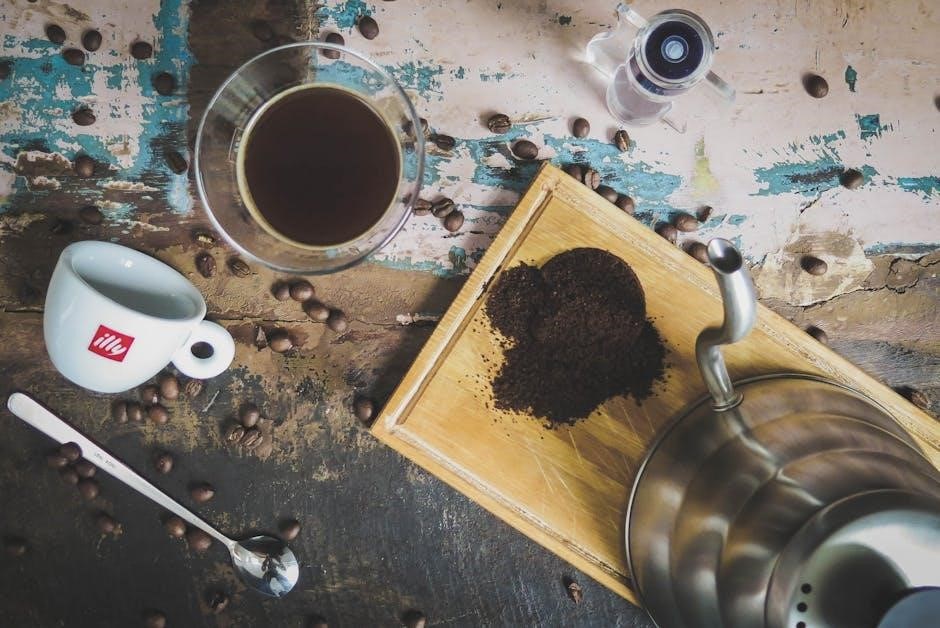
Brewing with a Vintage Grinder
Brewing with a vintage grinder offers precise control over grind size and flavor, providing a sensory experience rooted in traditional coffee-making craftsmanship.
7.1 Pairing with Brewing Methods
Vintage manual grinders perfectly complement various brewing techniques, such as pour-over, French press, and Chemex. The precise grind control enhances each method’s unique characteristics, ensuring optimal extraction. For instance, a coarse grind suits French press, while a finer grind is ideal for espresso or Aeropress. This versatility allows users to experiment with different brewing styles, preserving the traditional connection between grinder and brew. The tactile experience of grinding aligns beautifully with manual brewing, creating a harmonious ritual that celebrates both flavor and craftsmanship.
7.2 Achieving Optimal Grind Size
Achieving the optimal grind size with a vintage manual grinder requires careful adjustment. The grind size determines extraction quality, so it’s essential to match it to your brewing method. For coarse grinds, like French press, set the grinder to a larger particle size. For finer grinds, such as espresso, tighten the adjustment knob for a denser consistency. Regular calibration ensures precision, while testing the grind with a sifter or your fingers helps refine the setting. Consistent grind size enhances flavor and ensures a balanced brew every time.
7.3 Enhancing Flavor Profile
Using a vintage manual grinder enhances the flavor profile by preserving coffee’s natural oils and aromas. The slow, manual process avoids heat buildup, which can degrade beans. Experimenting with bean origins and roast levels further tailors the taste. Coarse grinds bring out bold, earthy notes, while finer grinds highlight bright acidity. Pairing freshly ground coffee with complementary brewing techniques maximizes complexity. The tactile experience of grinding also connects users to the craft, elevating the sensory enjoyment and making each cup a unique, flavorful experience rooted in tradition and quality.
Market Trends and Availability
Vintage manual coffee grinders are gaining popularity, driven by demand for sustainable, artisanal coffee experiences. Their availability spans antique shops, online marketplaces, and specialty stores, catering to both collectors and coffee enthusiasts.
8.1 Popularity in Modern Times
Vintage manual coffee grinders have seen a resurgence in popularity, appealing to coffee enthusiasts who value craftsmanship and sustainability. Their tactile, hands-on nature aligns with the trend toward artisanal coffee experiences. Collectors and home brewers alike appreciate their timeless design and the ritual of grinding coffee by hand. This popularity is further fueled by the desire for eco-friendly alternatives to electric grinders and the charm of owning a piece of coffee history. As a result, vintage grinders are sought after for both functional and aesthetic reasons.
8.2 Availability in Antique Shops
Vintage manual coffee grinders are often found in antique shops, flea markets, and estate sales. Their availability varies by region, with European models, particularly from France and Italy, being highly sought after. Many grinders are still functional, though some may require minor restoration. Antique dealers specializing in kitchenware frequently carry these items, catering to collectors and coffee enthusiasts. The charm of these grinders lies in their historical significance and craftsmanship, making them a prized find for those who appreciate both functionality and aesthetics.
8.3 Online Marketplaces
Online marketplaces like eBay and Etsy offer a wide selection of vintage manual coffee grinders. These platforms provide convenient access to rare and unique models from various sellers worldwide. Buyers can often find grinders in excellent condition, with detailed descriptions and photos. It’s important to check seller ratings and reviews to ensure authenticity and quality. Additionally, some niche websites specialize in vintage kitchenware, making them excellent resources for collectors seeking specific brands or designs. Online shopping allows for global browsing, enabling enthusiasts to discover and purchase grinders they might not find locally. Auction features on these sites can also lead to exciting deals for those willing to bid.
Preservation and Display
Vintage manual coffee grinders can be preserved by storing them in a cool, dry place, away from direct sunlight. Display them on shelves or in glass cabinets to showcase their craftsmanship and historical charm. Regular cleaning with a soft cloth ensures they remain in pristine condition for years to come.
9.1 Storage and Display Tips
Store vintage manual coffee grinders in a cool, dry place to prevent rust and moisture damage. Use a soft cloth to protect surfaces from dust. For display, place grinders on a shelf or in a glass cabinet to showcase their craftsmanship. Avoid direct sunlight to preserve finish and color. Consider using protective coverings or stands to enhance presentation. Displaying them in a kitchen or dining area adds charm and highlights their historical significance. Ensure they are out of reach of children to maintain their condition and safety.
9.2 Showcasing in Coffee Stations
Vintage manual coffee grinders add a touch of elegance to coffee stations. Place them on countertops or shelves to create a focal point. Pair the grinder with complementary items like antique coffee cups, classic brewers, or vintage-themed accessories. This setup not only highlights craftsmanship but also tells a story of coffee’s heritage; Ensure the grinder is clean and well-maintained to enhance its appeal. Displaying it near your brewing area showcases its functionality and adds charm to your coffee-making ritual, making it a conversation starter for guests.
9.3 Museum and Exhibit Examples
Vintage manual coffee grinders are often showcased in specialty coffee museums and historical exhibits worldwide. For instance, the Coffee Museum in Venice, Italy, and the London Coffee Museum feature antique grinders, highlighting their role in coffee culture. These exhibits provide detailed histories, craftsmanship insights, and demonstrations of grinding techniques. They educate visitors on the evolution of coffee preparation and the significance of manual grinders in preserving traditional methods. Such displays not only honor the past but also inspire appreciation for artisanal coffee practices in contemporary times, making them invaluable resources for coffee enthusiasts.
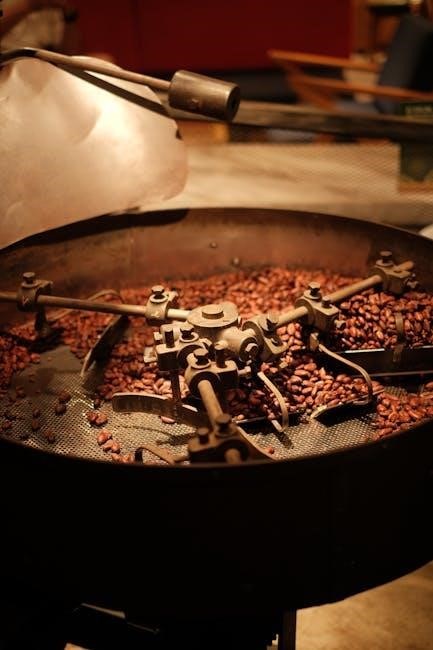
Cultural and Artisanal Significance
Vintage manual coffee grinders embody artisanal craftsmanship and cultural heritage, connecting people to traditional coffee-making practices and the rich history of coffee preparation worldwide.
10.1 Artisanal Craftsmanship
Vintage manual coffee grinders showcase exceptional artisanal craftsmanship, reflecting the skill and attention to detail of their makers. Often constructed from high-quality materials like brass, wood, and steel, these grinders were built to last. The intricate mechanisms, such as adjustable burrs and decorative engravings, highlight the precision and care invested in their creation. Each grinder is a testament to the craftsmanship of earlier eras, blending functionality with aesthetic appeal. This artisanal quality makes them highly sought after by coffee enthusiasts and collectors alike, preserving the legacy of traditional craftsmanship.
10.2 Cultural Impact and Heritage
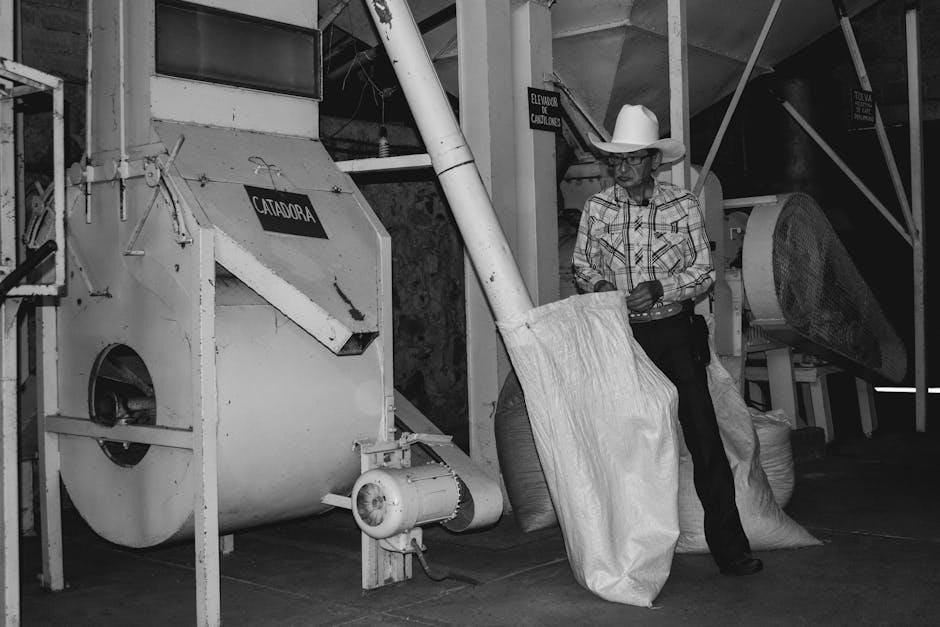
Vintage manual coffee grinders hold a significant place in cultural heritage, symbolizing a connection to traditional coffee-making rituals. They were often at the heart of social gatherings, fostering community and conversation. The grinders’ enduring presence across centuries highlights their role in shaping coffee culture worldwide. As artifacts, they embody the craftsmanship and values of past generations, serving as a bridge between historical traditions and modern coffee enthusiasts. Their preservation ensures the continuation of a rich cultural legacy, celebrating the art of coffee preparation.
10.3 Role in Modern Coffee Culture
Vintage manual coffee grinders have experienced a resurgence in modern coffee culture, cherished for their tactile charm and ability to produce high-quality grinds. Specialty coffee enthusiasts and cafes often use them to highlight the artisanal aspect of coffee preparation. Their manual operation encourages a slower, more mindful brewing process, appealing to those seeking a more intimate connection with their coffee. Additionally, their compact designs and nostalgic appeal make them popular in minimalistic and eco-conscious lifestyles, reinforcing their relevance in today’s coffee trends.
